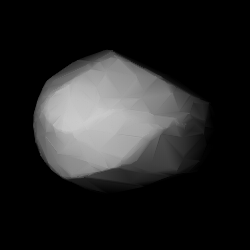Astronomy:2384 Schulhof
 Shape model of Schulhof from its lightcurve | |
| Discovery [1] | |
|---|---|
| Discovered by | M. Laugier |
| Discovery site | Nice Obs. |
| Discovery date | 2 March 1943 |
| Designations | |
| (2384) Schulhof | |
| Named after | Lipót Schulhof [2] (Hungarian astronomer) |
| 1943 EC1 · 1943 GV 1960 FE · 1962 WL1 1970 RP · 1981 FF A909 BF | |
| Minor planet category | main-belt [1][3] · (middle) Schulhof [4] |
| Orbital characteristics [3] | |
| Epoch 23 March 2018 (JD 2458200.5) | |
| Uncertainty parameter 0 | |
| Observation arc | 108.97 yr (39,803 d) |
| |{{{apsis}}}|helion}} | 2.9231 AU |
| |{{{apsis}}}|helion}} | 2.2989 AU |
| 2.6110 AU | |
| Eccentricity | 0.1195 |
| Orbital period | 4.22 yr (1,541 d) |
| Mean anomaly | 256.37° |
| Mean motion | 0° 14m 0.96s / day |
| Inclination | 13.530° |
| Longitude of ascending node | 7.9084° |
| 205.72° | |
| Physical characteristics | |
| Mean diameter | 11.485±0.174 km[5] 11.721±0.138 km[6] 12.66 km (calculated)[7] |
| Rotation period | 3.294±0.006 h[8] |
| Geometric albedo | 0.21 (assumed)[7] 0.2733±0.0217[6] 0.280±0.045[5] |
| S (assumed) [7] | |
| Absolute magnitude (H) | 11.7[6] 11.8[3][7] |
2384 Schulhof (prov. designation: 1943 EC1) is a mid-sized asteroid and the namesake of the Schulhof family, located in the Eunomian region of the intermediate asteroid belt. It was discovered on 2 March 1943, by French astronomer Marguerite Laugier at Nice Observatory in southeastern France.[1] The asteroid was later named after Hungarian astronomer Lipót Schulhof.[2] The presumed S-type asteroid has a short rotation period of 3.3 hours and measures approximately 12 kilometers (7.5 miles) in diameter.
Orbit and classification
Schulhof is the principal body and namesake of the Schulhof family, a small asteroid family within the region of the Eunomia family of the main-belt.[4][9] It orbits the Sun in the central asteroid belt at a distance of 2.3–2.9 AU once every 4 years and 3 months (1,541 days). Its orbit has an eccentricity of 0.12 and an inclination of 14° with respect to the ecliptic.[3] It was first observed as A909 BF at Heidelberg Observatory in 1909. The body's observation arc begins with its official discovery observation at Nice in 1943.[1]
Naming
This minor planet was named in memory of Austrian–Hungarian astronomer Lipót Schulhof (1847–1921), observer of asteroids and comets, discoverer of the main-belt asteroid 147 Protogeneia, and awardee of the Lalande Prize.[2] The official naming citation was published by the Minor Planet Center on 17 February 1984, based on a suggestion by Brian G. Marsden (M.P.C. 8541).[10]
Physical characteristics
Schulhof is an assumed S-type asteroid.[7]
Rotation period

In April 2002, a rotational lightcurve of Schulhof was obtained from photometric observations at the U.S. Oakley Observatory. It gave a well-defined rotation period of 3.294±0.006 hours with a brightness variation of 0.43 magnitude ({{{1}}}).[8]
Diameter and albedo
According to the survey carried out by the NEOWISE mission of NASA's Wide-field Infrared Survey Explorer, Schulhof measures 11.5 and 11.7 kilometers in diameter and its surface has an albedo of 0.27 and 0.28, respectively.[5][6] The Collaborative Asteroid Lightcurve Link assumes an albedo of 0.21 – derived form 15 Eunomia, the family's largest member and namesake – and calculates a diameter of 12.7 kilometers with an absolute magnitude of 11.8.[7]
References
- ↑ 1.0 1.1 1.2 1.3 "2384 Schulhof (1943 EC1)". Minor Planet Center. https://www.minorplanetcenter.net/db_search/show_object?object_id=2384. Retrieved 9 August 2018.
- ↑ 2.0 2.1 2.2 Schmadel, Lutz D. (2007). "(2384) Schulhof". Dictionary of Minor Planet Names. Springer Berlin Heidelberg. p. 194. doi:10.1007/978-3-540-29925-7_2385. ISBN 978-3-540-00238-3.
- ↑ 3.0 3.1 3.2 3.3 "JPL Small-Body Database Browser: 2384 Schulhof (1943 EC1)". Jet Propulsion Laboratory. https://ssd.jpl.nasa.gov/sbdb.cgi?sstr=2002384. Retrieved 9 August 2018.
- ↑ 4.0 4.1 "Asteroid 2384 Schulhof". Small Bodies Data Ferret. https://sbntools.psi.edu/ferret/SimpleSearch/results.action?targetName=2384+Schulhof. Retrieved 9 August 2018.
- ↑ 5.0 5.1 5.2 Masiero, Joseph R.; Grav, T.; Mainzer, A. K.; Nugent, C. R.; Bauer, J. M.; Stevenson, R. et al. (August 2014). "Main-belt Asteroids with WISE/NEOWISE: Near-infrared Albedos". The Astrophysical Journal 791 (2): 11. doi:10.1088/0004-637X/791/2/121. Bibcode: 2014ApJ...791..121M. http://adsabs.harvard.edu/cgi-bin/bib_query?bibcode=2014ApJ...791..121M. Retrieved 7 December 2016.
- ↑ 6.0 6.1 6.2 6.3 Mainzer, A.; Grav, T.; Masiero, J.; Hand, E.; Bauer, J.; Tholen, D. et al. (November 2011). "NEOWISE Studies of Spectrophotometrically Classified Asteroids: Preliminary Results". The Astrophysical Journal 741 (2): 25. doi:10.1088/0004-637X/741/2/90. Bibcode: 2011ApJ...741...90M.
- ↑ 7.0 7.1 7.2 7.3 7.4 7.5 "LCDB Data for (2384) Schulhof". Asteroid Lightcurve Database (LCDB). http://www.minorplanet.info/PHP/generateOneAsteroidInfo.php?AstInfo=2384%7CSchulhof. Retrieved 5 July 2016.
- ↑ 8.0 8.1 Ditteon, R.; Bixby, A. R.; Sarros, A. M.; Waters, C. T. (December 2002). "Rotation Periods and Lightcurves of 1858 Lobachevskij, 2384 Schulhof and (5515) 1989 EL1". Minor Planet Bulletin 29 (1): 69. Bibcode: 2002MPBu...29...69D. http://www.minorplanet.info/MPB/issues/MPB_29-1.pdf. Retrieved 18 March 2020.
- ↑ Nesvorný, D.; Broz, M.; Carruba, V. (December 2014). "Identification and Dynamical Properties of Asteroid Families". Asteroids IV. pp. 297–321. doi:10.2458/azu_uapress_9780816532131-ch016. ISBN 9780816532131. Bibcode: 2015aste.book..297N.
- ↑ "MPC/MPO/MPS Archive". Minor Planet Center. https://www.minorplanetcenter.net/iau/ECS/MPCArchive/MPCArchive_TBL.html. Retrieved 5 July 2016.
External links
- Lightcurve Database Query (LCDB), at www.minorplanet.info
- Dictionary of Minor Planet Names, Google books
- Asteroids and comets rotation curves, CdR – Geneva Observatory, Raoul Behrend
- Discovery Circumstances: Numbered Minor Planets (1)-(5000) – Minor Planet Center
- 2384 Schulhof at AstDyS-2, Asteroids—Dynamic Site
- 2384 Schulhof at the JPL Small-Body Database
 |

